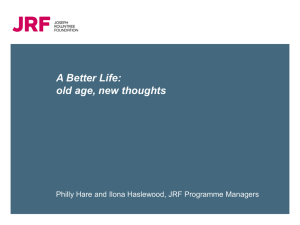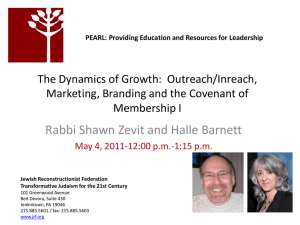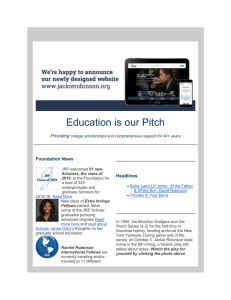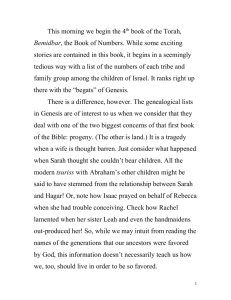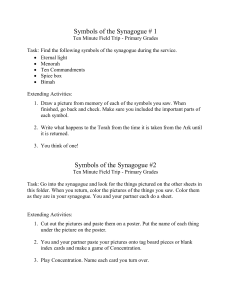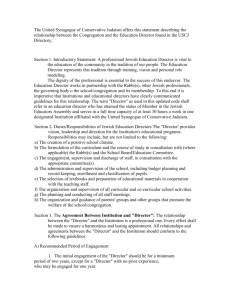Towards a Globally Sustainable Evolving Religious Civilization of
advertisement
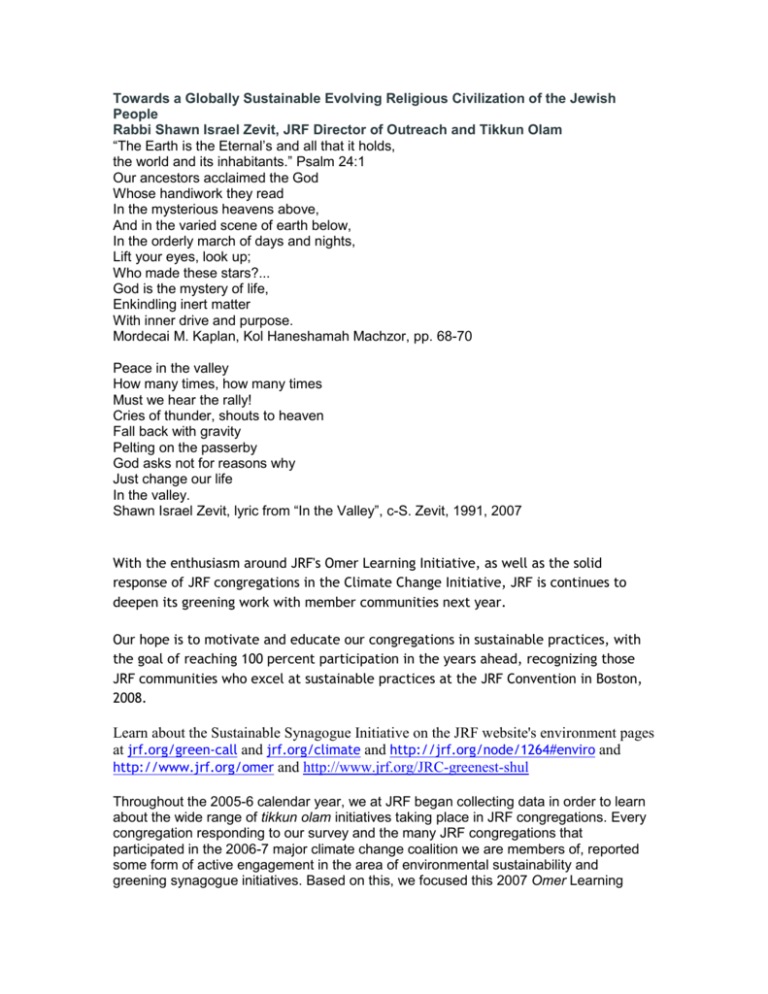
Towards a Globally Sustainable Evolving Religious Civilization of the Jewish People Rabbi Shawn Israel Zevit, JRF Director of Outreach and Tikkun Olam “The Earth is the Eternal’s and all that it holds, the world and its inhabitants.” Psalm 24:1 Our ancestors acclaimed the God Whose handiwork they read In the mysterious heavens above, And in the varied scene of earth below, In the orderly march of days and nights, Lift your eyes, look up; Who made these stars?... God is the mystery of life, Enkindling inert matter With inner drive and purpose. Mordecai M. Kaplan, Kol Haneshamah Machzor, pp. 68-70 Peace in the valley How many times, how many times Must we hear the rally! Cries of thunder, shouts to heaven Fall back with gravity Pelting on the passerby God asks not for reasons why Just change our life In the valley. Shawn Israel Zevit, lyric from “In the Valley”, c-S. Zevit, 1991, 2007 With the enthusiasm around JRF's Omer Learning Initiative, as well as the solid response of JRF congregations in the Climate Change Initiative, JRF is continues to deepen its greening work with member communities next year. Our hope is to motivate and educate our congregations in sustainable practices, with the goal of reaching 100 percent participation in the years ahead, recognizing those JRF communities who excel at sustainable practices at the JRF Convention in Boston, 2008. Learn about the Sustainable Synagogue Initiative on the JRF website's environment pages at jrf.org/green-call and jrf.org/climate and http://jrf.org/node/1264#enviro and http://www.jrf.org/omer and http://www.jrf.org/JRC-greenest-shul Throughout the 2005-6 calendar year, we at JRF began collecting data in order to learn about the wide range of tikkun olam initiatives taking place in JRF congregations. Every congregation responding to our survey and the many JRF congregations that participated in the 2006-7 major climate change coalition we are members of, reported some form of active engagement in the area of environmental sustainability and greening synagogue initiatives. Based on this, we focused this 2007 Omer Learning Initiative on the theme of environmental, social, political, economic and spiritual sustainability. Over the seven weeks of teaching, congregations and individuals will have the opportunity to share with us the projects their congregations have been involved with, present background information related to the issue, and help us think about ways in which our communities might respond to the ecological challenges we face today. Congregations were invited to organize internally and to apply to JRF’s Department of Tikkun Olam to generate teachings on a given week of the Omer. Each week, the teachings are based on texts about sustainability and environmental concerns supplied by JRF, as well as of the community’s own choice, weaving in their congregational and individual environmental practices. At the end of the seven weeks, a rich tapestry of resources, practices and teaching modules were generated and permanently available in the Tikkun Olam section of the JRF website. See http://www.jrf.org/omer Mordecai Kaplan argued that Jewish life must provide us with recipes for justice in the world when he wrote, “A theology which is not a plan of social action is merely a way of preaching and praying. It is a menu without the dinner.” (Not So Random Thoughts) If we are to have a viable future as a Jewish People, we need to build on Kaplan’s formulation of Judaism as an evolving religious civilization to include a globally sustainable approach to living in faith community. A globally sustainable, evolving religious culture will also include interdependent and healthy economic, social, political, environmental and spiritual systems. For us as Jews, as non-Jewish partners and allies sharing a Jewish path, and as human beings on this planet, there may be no more important issue to engage in and face than the issue of global sustainability in the 21st century. To achieve individual self-realization and the ongoing renewal of the Jewish people, includes personal health and well-being, spiritual practices, ritual, study, building mutually supportive relationships, as well as community organizing and balanced activism around environmental issues. I do not offer this idea as a nice altruistic teaching that we can get to if we have discretionary time. An eco-spiritual consciousness is one which we simply must embrace if we are to continue to exist in this world. The interdependent ecosystem of the planet as a whole, or “Gaia” as James Lovelock phrased it in the 1960’s, does not prefer one religion or political system over the other when it comes to climate change and global sustainability. From space, there are no borders. Everything changed when we beheld our precious blue planet when the Apollo astronauts aimed their camera at Earth. It is this image I hold in my heart and mind when I pray the Aleynu at the end of each service. “You are one, and Your Name is One” is not a call for some supernatural messianic future or the world as we would fantasize it to be, but a rallying call to quickly re-align our actions individually, communally, and internationally towards a sustainable future beginning this day! The Torah states, “Justice, justice you shall pursue” (Deuteronomy 16:20). Our imperative is to pursue responses to the many areas of concern we face in North America. For us as Jews, social, economic, or environmental problems are not "inconvenient truths," but realities to be fully met as part of our Jewish values of Spiritual Peoplehood in the broadest coalitions and the smallest local initiatives. Together we can pursue the Divine call to do what is just for tikkun hanefesh (healing the individual soul) and tikkun olam (healing the world Q. 1)If you imagine yourself at the end of this year, what action(s) do you most want to change in your personal lifestyle to include a sustainability consciousness? What about as a faith community? Q. 2) How do the ideas above relate to your current spiritual and Jewish cultural life? How does your current personal and communal way of life impact the local and larger eco-systems of which you are a part? For additional resources on the Omer Learning Initiative or Greening Synagogues, go to our environment page at http://www4.jrf.org/climate Selected text from JRF’s Resolution on the Environment, passed in the late 1980’s: For the full resolution see http://www4.jrf.org/showres&rid=262 Rabbi Shawn Israel Zevit, is the JRF Director of Outreach & Tikkun Olam, and a congregational consultant for the Jewish Reconstructionist Federation. He represents the Reconstructionist Movement to prospective affiliates and the larger Jewish world, as well as developing and delivering resources and leadership workshops for JRF congregations. See www.rabbizevit.com for music and additional writings. Jewish Reconstructionist Federation JRF Conference Call “Greening Synagogues and Living a Sustainable Life Rooted in Jewish Values” http://www.jrf.org/green-call Together we can make a difference: JRF's Synagogue Greening Initiative With the enthusiasm around JRF's Omer Learning Initiative, as well as the solid response of JRF congregations in the Climate Change Initiative, JRF is planning to deepen its greening work with member communities next year. Our hope is to motivate and educate our congregations in sustainable practices, with the goal of reaching 100 percent participation in the years ahead. In response to calls from professional and lay leaders seeking help in setting up a greening committee or identifying sustainability projects in their own communities, JRF hosted a North American Synagogue Greening Conference Call. More than 60 people from 40 JRF congregations participated! The call included an overview of our movement's work in this area from Rabbi Shawn Zevit, JRF's Director of Outreach and Tikkun Olam; Rabbi Fred Dobb of Adat Shalom synagogue in Bethesda, MD, and a COEJL board member; and RRC rabbinical student Derek Rosenbaum, JRF Tikkun Olam Intern 2006-'07. Topics and the speakers who addressed them on the call, included: Greening Synagogue practices with Julie Dorfman of the Jewish Reconstructionist Congregation (JRC) in Evanston, IL. JRC is currently undergoing a full reconstruction of its building according to green architecture principles, including obtaining LEED certification (Leadership in Energy and Environmental Design) from the U.S. Green Building Council Everyday sustainability across the synagogue system with Cantor Eric Schulmiller of the Reconstructionist Synagogue of the North Shore (RSNS) in Plandome, NY, the first "carbon-neutral' synagogue. Eco-Kashrut and Greening Synagogue practices with Rabbi Yitz Husbands-Hankin of Temple Beth Israel, Eugene, OR The call began with an overview of our movement’s work to date by Rabbi Shawn Zevit (JRF Director of Outreach and Tikkun Olam) and Rabbi Fred Scherlinder Dobb (Adat Shalom in Bethesda, MD and COEJL) Shawn began with opening remarks about how sustainability and the environment has recently been a mainstream focus of big business and the media. Last month Marriott Hotel unveiled a True Green policy. The Jerusalem Post ran a feature on Greening in Israel; The NY Times Magazine (May 20) had a cover story on “Eco-tecture: designing and building with the environment in mind;” MacLean’s ran a May 14th cover story entitled “Bottled Water: The Latest Environmental Sin;” Newsweek (Apr 16) featured Gov. Schwarzenegger on the cover for their article “Save the Planet or Else: Green cities, science and CO2, China’s water crisis, global carbon tax?, generation green, big and small fixes…;” and even Mad Magazine (May 2007) had a cover stating “We Salute Global Warming!” As the environment is now a mainstream cause, this must be a core issue of Reconstructionist Judaism. For this reason, and based upon congregational responses to the 2006 Tikkun Olam Survey, we partnered with COEJL on the Climate Change Initiative and made Sustainability and the Environment the focus of the 2007 Omer Learning Initiative. Over 800 people signed up for the Omer project listserve and the Omer teachings accounted for the largest number of hits on JRF website. Shawn concluded with a quote from Oliver Thomas’ article “God Goes Green” from USA Today (Mon, June 4th): “Despite the fact that 90% of us say we believe in God, most North Americans appear reluctant to begin making the sacrifices necessary to address global warming… People of faith have been at the forefront of nearly every great social movement in history, starting with the abolitionist movement. The jury is still out on whether we will rise to the occasion this time.” Rabbi Fred began his piece by saying “Shema Yisrael!” It is a message that must be heard. “Shema” means to understand and act upon. We are now at a point as a community where, a) we must learn with and from each other, and b) we are all still on the ground floor of a transformative and transforming movement. Fred attended a Teva Learning Center conference on Monday, where he received a big round of applause when he announced that half of the congregations in our movement were to be represented on this phone call. Fred then discussed the history of Jewish environmental activism. In 1988 Ellen Bernstein founded Shomrei Adamah, the first Jewish environmental organization, with Mordecai Liebling. In 1992 COEJL began. Since then, The Teva Learning Center, HAZON, Adamah, Confei Nesharim, and Israeli groups such as Adam Teva v’Din, The Heschel Center, and the Aravah Institute sprung forth. Also, national interfaith movements, such as the National Religious Partnership on the Environment, were created. We are proud of the large visibility of Reconstructionist leaders in these groups. We now have a sacred opportunity to build on these efforts. Some examples of our groundbreaking work are the Jewish Reconstructionist Congregation’s (JRC; Evanston, IL) path to becoming the poster synagogue for Greening Synagogue Initiatives and Beit Haverim’s (Atlanta, GA) Hanukkah environmental text study, and the Idle Worship program at Temple Beth Israel in Eugene, OR. This call’s goal is to kick off the collective process. We must begin by asking ourselves: What does a unique Reconstructionist voice within the Jewish environmental movement look like? To answer, we must include our understanding of Judaism as evolutionary, the importance of process, inclusivity, radical openness, and the notion of sacred community. Three ideas to keep in mind as we continue this work are: 1) Shabbat, 2) Halachah – do’s and don’ts, and 3) environmental justice – the interchange between human and environment, bearing in mind that we are created in the image of God. Next, Julie Dorfman of JRC spoke about her congregations greening synagogue practices. Their environmental group developed as a task force of the Social Action Committee. There was a conscious effort to move from model of “THEY should do it” to “WE should do it” and there was a belief that focusing on environmental concerns was an ethical and moral imperative. The task force started by switching the synagogue to using recycled paper and compact fluorescent light bulbs (CFLs). They also created a flyer with environmental suggestions for congregants to read and held an environmental seder during Passover. The seder was successful: 70 people registered and 110 came. Then, JRC decided to rebuild their building. Rabbi Fred Scherlinder Dobb came to speak about greening synagogues on a Shabbat and met with the board and the zoning task force. Fred energized the congregation; everyone wanted a green synagogue like Adat Shalom’s. Then-president Carole Caplan, Rabbi Rosen, and the task force then got together to draft a resolution emphasizing the Jewish value of Baal Tashchit (Don’t Waste). They presented it to the board where it was adopted unanimously and handed to architect. Next, JRC pursued LEED Certification (http://www.usgbc.org/DisplayPage.aspx?CategoryID=19). JRC applied for and received a grant for $105,000 for incremental greening architecture. The money was a huge boost to the capital campaign and served to commit the congregation to the project. The LEED Certification, run through the US Green Building Council, is a program composed of 69 performance benchmarks. How well you meet these benchmarks determines the standard of certification. JRC is pursuing the Gold Standard. One benchmark is sustainable construction of the new building; the project aims to reduce waste by 75% by using the old building as fill for the new building. When demolished, the materials from the old building were weighed and recycled or put in a landfill. 96% was reclaimed or recycled, while only 4% went to landfill. The new building will save over 40% in water through the installation of special toilets and faucets. Only native plants will be used in landscaping. As for energy optimization, they will install a displacement air conditioning system that delivers air low on the wall and will have panels with digital controls; the building is projected to consume 42% less energy than a conventional building. The materials used are also environmentally friendly. The exterior siding is from reclaimed wood from barns in upstate Illinois. The non-toxic paints and adhesives used will improve indoor air quality, thereby making fewer sick from respiratory infection and protecting the health of construction workers. They will use only green cleaning supplies. JRC is involved in an education outreach program around Chicago to share their knowledge. This has been a challenging project in certain ways, especially when it came to financial considerations. For instance, they couldn’t afford a green roof, so instead they made a reflective roof, which is relatively inexpensive. Also, it was decided to add a solar ner tamid (eternal light) in the future. The JRC community experienced a lot of growth through this project, found that resources come out of the woodworks, and made strong connections with the broader interfaith community (Faith and Space program?) Shawn asked the question: In terms of Jewish identity, “what are the byproducts of this project”? Julie responded that Rabbi Rosen chose this topic for his Kol Nidre sermon. Also, it energized the community to become more active. The project is seen as a values-based decision. They showed Al Gore’s documentary“An Inconvenient Truth”. The lessons of this project was connected with social justice work and gave everyone involved a better understanding of how resources can cause global problems. Shawn then reflected that these issues don’t come out of a vacuum. JRC’s Community Covenant is exemplary in redefining what it means to be a member in a covenantal community. Rabbi Yitz Husbands-Hankin of Temple Beth Israel (Eugene, Oregon) spoke about the “process” aspect of greening synagogues. At Temple Beth Israel, there was a focus on environmentalism in the community and the congregants were passionate about the issue. Their main work was to translate this passion into a Jewish imperative. This was done through having conversations in the community in the form of classes, newsletters, and other written pieces. These conversations dealt with ethical, moral issues and halakhic imperatives concerning such issues as justice, the treatment of animals, and preservation of the global climate. The goal was to talk about these issues in terms of Torah-rooted ideas and values: Baal Tachshit, not exploiting workers, etc. The congregation formed an “Honoring Nature” committee that included people who had experience working in this field in the community. The committee suggested an inventory be taken of congregants’ practices to see how to best make improvements in the areas of cleaning materials, energy use, recycling, etc. The model created was that of a small core of activists plus a broader congregation ready to take the cause to heart. Out of this came a drive to create a new building. They showed the movies “Blue Vinyl” and “An Inconvenient Truth” and got involved in a CSA (Community Supported Agriculture) and other organizations. Having taught and translated environmentalism into Jewish values, it is now a core conversation. Temple Beth Israel is looking at LEED Certification to draw from the standards but is not in a financial position to pay for it. Environmental work is now seen as a spiritual, religious imperative – their obligation as Jews. Through this process, their interfaith networking has strengthened the community by giving vitality to Judaism. Yitz sees the process as education and looking into the passions of the community. Shawn remarked that our goal is to make environmental activism not an inconvenient truth but rather a necessary response. We must reconstruct Judaism in this way as we did two thousand years ago after the destruction of Second Temple. Also, our spiritual path as environmentally conscious people can connect loosely affiliated and unaffiliated Jews to Judaism. Next, Cantor Eric Schulmiller of RSNS in New York spoke about everyday sustainability across the synagogue system. Over the past two years, RSNS has been building momentum in environmental action. The two main goals are to 1) create a wonderful outreach tool to the larger world, such as leading the congregation to work towards social justice, and 2) inform, inspire and encourage members to engage on an individual level, as we have done on a congregational level, to be more aware in their practices. In 2005, RSNS switched to 100% Green energy through their electric company, becoming the first "carbon neutral" synagogue in the country. They are the first synagogue in the country to be awarded membership in the EPA Green Power Leadership Club. At the Yom Kippur Avodah service, they launched a campaign for members to switch to follow their lead and green energy through a similar residential program by distributing applications to all 350 households. In 2006, they installed an energy-efficient motion sensor lighting system, upgraded windows, and replaced most incandescent bulbs with CFL's throughout building. They joined COEJL/JRF's Light Unto the Nations campaign by encouraging all members to also purchase CFL's for their home. Also, RSNS became the first Reconstructionist synagogue accepted into the Tuv Ha'aretz Jewish CSA program of Hazon. RSNS also hosts the weekly pickup of organic produce through a partnership with a local organic farm on Long Island and offers holiday-based programming and farm trips throughout the year to develop the connection between Judaism and what we consume, i.e. "Eco-Kashrut" (their CSA page is at: www.xrl.us/rsnscsa). They now feature organic food at onegs and other functions in the synagogue. In 2007, they switched the office to 100% post-consumer recycled paper. RSNS is not in the process of launching a more aggressive anti-idling campaign for synagogue school pickup, exploring the addition of a "green line" to their synagogue budget, and hopes to organize congregant purchasing of green cleaning supplies, fair trade coffee for synagogue functions, and environmentally friendly food service items (check out www.newdream.org) in addition to sustaining their ongoing 100% Green Energy purchase and supporting their organic CSA. Next, Shawn read a question posed in an email by Bill Witherspoon of Congregation Beit Haverim: “We are struggling on helping kids with environmental interests to develop meaningful B'nai Mitzvah Tikkun Olam projects. Any experiences to share?” Julie gave examples of one child who sold COEJL light bulbs and another who planted trees. Eric suggested that at the party reception you can donate to HAZON or City Harvest, you can have a carbon neutral reception to raise awareness, and a child can wear t-shirt about not idling in the parking lot at the end of Hebrew school sessions. Yitz suggested that the child can mention environmental awareness in her/his d’var torah. Shawn then asked how we can change the larger culture in areas where we live. Fred explained that there is an active and a passive approach. An active approach can include joining the steering committee for Interfaith Power and Light. The passive involves being a dugmah ishit (personal example) to do the right thing; for example, the congregation can place booklets by the siddurim about environmental features of the synagogue. Yitz mentioned the “That’s My Farmer” project and how he raised a lot of awareness about the environment by purchasing an E-Bike. The final topic discuss was Ethical and Eco-Kashrut. Shawn explained that halakhah is an informative factor, but in the Reconstructionist Movement kashrut is mainly based on ethics and environmental concerns. Yitz brought up the question of whether it is kosher to use power from a nuclear power plant. This questions stimulated great conversation about ethical kashrut in his congregation. It is imperative that this is a coalition-building project: connecting with the Conservative Movement and the Religious Action Committee of the Reform Movement over ethical and eco-kashrut. The values of ba'al tashchit (don’t waste), tzar ba'alei chayim (cruelty to animals), factory farming, and social justice/workers rights all are a part of this issue. Ethical kashrut goes beyond food to all the items we use in our lives. Max Fischlowitz Roberts – sent list of books about eco-kashrut Regarding the direction JRF is headed in, Shawn mentioned that the JRF became a member of the JCPA yesterday. We want to have a spiritual sustainability plan, a “LEEDS” for Jewish life. In the year ahead, we plan to have more conference calls on specific areas of environmental activism. Another question posed by an email is: How can we know if the products we use violate Jewish ethical standards? Yitz recommended looking at www.coopamerica.com. Eric suggested www.speatshopwatch.org and The Green Guide (a balanced look at economic and social justice). Fred suggested www.coejl.org/greensyn, which features building renovation suggestions and programmatic pieces. Shawn requested participants in the call to send in more resources. Another question was posed: Why are we using what we’re using to begin with? This is the issue of voluntary simplicity, on which there is an article on JRF website concerning value orientation. As a conclusion, Shawn read from the JRF Resolution on the Environment. He then read the Shema rewritten from environmental perspective (from Ahavat Olam in Vancouver, BC: www.ahavat-olam.ca ) VeHayah Im Shamo’a (Deut 11:13-21) If you really listen to the words of the teaching that I give you this day: That is: to love God and serve God wholeheartedly, Then the difficulties of this life will seem less harsh, Because God’s presence will guide you. Be careful not to think that your accomplishments are yours alone, Rather remember that it is God’s grace that empowers you. KNOW THAT YOU ARE PART OF THE CYCLES OF THIS LIFE, THAT WHAT YOU DO WILL COME BACK TO YOU: That if you do not love yourself, the world will appear loveless That is you do not respect the godliness in others, God’s presence will not be apparent to you: THAT IF YOU PUT TOXINS INTO YOUR AIR, EARTH, AND WATER, THEY WILL REAPPEAR AS POISINS IN YOUR FOOD Remember that these consequences result from losing touch with your God… Work hard on this connectedness, Knowing that it will not be easy, But knowing that it could easily give you peace of mind… And that you may live contentedly here On this planet For as long as the heavens are above the earth. Notes submitted June 13th, 2007/5767 by: Derek Rosenbaum Rabbi Shawn Zevit Department of External Affiliations and Tikkun Olam Jewish Reconstructionist Federation Drash from Cantor Eric Schulmiller, the Reconstructionist Synagogue of the North Shore He connected our mission with the Earth Aid Kits and conservation with that of Tu B’Shvat. On Tu B’Shvat, we connect with the kabbalists who focus on intention – that beyond our basic sensory pleasures, we must appreciate with kavannah (simply defined as intent) the food and all else that we consume. But when we approach our consumption of energy with kavannah - in full awareness of the efforts needed to procure that energy and the resultant effects of its use, then we begin to become aware of the preciousness of the seemingly-endless flow of electricity that lights our homes, runs our computers and tv’s, and drives our cars. Imagine if we said a b’racha each time we turned on a light, booted up our computer, or turned the key in our ignitions? We might come to realize, as even Jim Rogers from Duke energy has said, that "The most environmentally sound, inexpensive and reliable power plant is the one we don't have to build,” and therefore try to conserve that which is most valuable to us, through the use of devices that can easily assist us in these efforts. First, a story told by Rabbi Joshua ben Chananiah in the Talmud: Said Rabbi Yehoshua ben Chananiah: "Once a child got the better of me. I was traveling, and I met with a child at a crossroads. I asked him, 'which way to the city?' and he answered: 'This way is short and long, and this way is long and short.' I took the 'short and long' way. I soon reached the city but found my approach obstructed by gardens and orchards. So I retraced my steps and said to the child: 'My son, did you not tell me that this is the short way?' Answered the child: 'Did I not tell you that it is also long? I then kissed him on the forehead and remarked: "Blessed are you, Israel, that all your children are wise, both great and small."(Talmud, Eruvin 53b) We often think of efficient as being synonymous with efficacious. But efficacious is from the root meaning to accomplish - get it done “by any means necessary.” Efficient is from the root meaning to create and was originally associated with the maker behind the action. So to be efficient doesn’t just mean the quickest, easiest solution, but we are at our most efficient when the cause is united with effect! The closest term we have for this type of efficiency in Judaism is kavannah. This seems entirely appropriate for today’s discussion. On Passover, millions of Jews eat a meal like first-century rabbis living under Roman culture. But on Tu B’Shvat, we eat a meal like 17th century Lurianic kabbalists! The primary goal of the kabbalists was to liberate the divine sparks in the world through engaging in our every day acts, such as eating, with the proper kavannah. As the original Tu B’Shvat seder, the Pri Etz Hadar, put it: “by means of the blessing, one draws down shefa- the divine flow of energy. The angel who is assigned to that fruit (which was eaten) is filled by the shefa so that a second fruit can replace the first." (Pri Etz Hadar) The easiest way to derive the nutrition from a piece of fruit is to rip of its peel, devour the fruit, and throw away the seeds. But the kabbalists understood that there’s more to our food than caloric content. The easiest way to power our planet is to rip off the top of a mountain or suck all the oil out of the ground and gorge ourselves on the fossil fuels, tossing the carbon back into our atmospheric garbage can. But when we approach our consumption of energy with kavannah - in full awareness of the efforts needed to procure that energy and the resultant effects of its use, then we begin to become aware of the preciousness of the seemingly-endless flow of electricity that lights our homes, runs our computers and tv’s, and drives our cars. Imagine if we said a b’racha each time we turned on a light, booted up our computer, or turned the key in our ignitions? We might come to realize, as even Jim Rogers from Duke energy has said, that "The most environmentally sound, inexpensive and reliable power plant is the one we don't have to build,” and therefore try to conserve that which is most valuable to us, through the use of devices that can easily assist us in these efforts. Immediately before the talmudic parable with which I began, Rabbi Joshua relates another anecdote of his travels through a field: Once I was travelling on a road and seeing a beaten path leading across a field I took that path. Said a little girl to me: "Rabbi! is this not a field that you are crossing?" and I answered: "Is this not a beaten path?" and she answered: "Yes, [because] robbers such as you have made it a beaten path!" (B.T. Eruvin, ibid.) Martin Luther King wrote the following words which speak to this ultimate point that to be efficient means to unite cause and effect: “[W]e will never have peace in the world until men everywhere recognize that ends are not cut off from means, because the means represent the ideal in the making, and the end in process, and ultimately you can’t reach good ends through evil means, because the means represent the seed and the end represents the tree." (1967) Explanation of Earth Aid Kits by Ben Bixby, CEO of Earth Aid Enterprise First, Ben can be reached at ben@earthaidenterprises.com. Earth Aid Kits are a collection of premium energy efficient products. They are simple (and simple to use!) tools that can be used to supplant or aid appliances everywhere around the house that draw electricity. The kits incentivize people to do more – when you buy 4 or more items, everything becomes cheaper and shipping is a flat rate of $5.00. All purchases* pay for themselves in time with reduced electricity bills. COEJL is working with Earth Aid Enterprises and the Jewish Council for Public Affairs (JCPA) to offer an option where you can donate Earth Aid Kits to low income seniors to help reduce our communal CO2 emissions and help them reduce their electricity costs! There is a special COEJL portal with discounted prices (on average, 25-33% cheaper than retail) that will also calculate all CO2 reductions made through the COEJL campaign. Check it out: http://coejl.earthaidkit.com. Ben recommended three ways to participate in the Earth Aid Kit campaign: 1) Direct people in your community towards the web-site and they can order directly to their home. 2) You can create your own web-site/portal for a city or even a unique one for your synagogue. If the Boston area wanted their own portal, the address would look something like: http://coejl.earthaidkit.com/boston. ; All emissions through these sites will still be calculated under COEJL’s total. 3) Earth Aid Enterprises will be making a printable order form that you can distribute and people can order as a community/synagogue in one joint purchase. Explanation of Products (more can be found on the website) Compact Fluorescent Lights (CFLs): Use approximately ¼ the energy of regular incandescents and can replace almost all bulbs. Comes in a few wattages. Light Emitting Diodes (LED) Nightlights: This 1W LED Night Light plugs right into a wall socket, and turns on automatically when the area darkens and turns off automatically when the area lightens up again. They are protected by a manufacturer's 100,000 hour guarantee. Smart Strip Power Strips: These sense when your computer or television shuts off. When it does, the Smart Strip automatically cuts power to your peripheral devices (monitor, speakers, DVD, etc.) to eliminate their 'phantom loads.' It also knows when to turn your devices on automatically - saving you time, money, and energy. Programmable Thermostats: Offsetting approximately one half of a car each year, a Programmable Thermostat is the single most impactful simple switch that you can make with your Earth Aid Kit. It allows you to keep your house a comfortable temperature while you are there without wasting energy while you’re gone. Digital 7 Day Appliance Timers: Similar to the programmable thermostat, this can control your air conditioning unit for when it needs to be in use. Rather than leaving your A/C on all day so that your home is cool when you return, simply use this timer to turn it off around the time you're usually leaving home and on 20 minutes before you're usually returning. You'll feel as cool walking in the door as if it had been on all day. You won't notice the difference - until you see the savings on your energy bill. Digital Tire Pressure Gauges: This easy-to-use and easy-to-read digital tire pressure gauge can help you keep your tire pressure at its ideal levels. Properly inflated tires improve your gas mileage and reduce your risk of a tire blowout. Oxygenating Showerheads: Increase your water pressure, add oxygen to the flow, save money, and fight global warming. Your skin (and your wallet) will thank you for upgrading to a top-of-the-line oxygenating showerhead! Heating water for homes is an exceptionally energy intensive process. Dollar-for-dollar, upgrading to an oxygenating showerhead is one of the most energy efficiency and money-saving moves you can make. Faucet Aerators: Heating water for homes is one of the most energy intensive processes that goes largely unnoticed. Equipping your sinks with faucet aerators can significantly reduce the amount of water wasted while rinsing dishes, washing your hands, or brushing your teeth. Dryer Balls: Skip the fabric softener sheets and cut your drying time by 25% by throwing two of these reusable dryer balls into your dryer every time you run it. It’s that simple! Weather Sensors: While these weather sensors don't directly save you energy, they can help you understand the phenomena that factor into home energy efficiency. By comparing your indoor and the outdoor temperatures, you can gain a sense of how hard your heating or air conditioning units are working and make your own decision about whether to open or close windows, or to adjust thermostats in rooms that may not be in use. *KW Meters: Coming soon. Kilowatt meters are digital devices that you plug into a socket and then plug your appliance in question into it – it will then tell you how much energy that appliance uses. This does not automatically reduce your energy consumption, but it does lead to more knowledgeable decisions with your home appliances. Environmental Links shared during the JRF Sustainable Synagogue Conference Call JRF environment resources: www4.jrf.org/climate and www4.jrf.org/omer Articles in Reconstructionism Today: The World as Sacred Space, Rabbi Fred Dobb, http://www.jrf.org/rt/2005/Winter-Vol12-2.pdf#page=13 Simplicity as a Jewish Path, Rabbi Moti Rieber, Betsy Teutsch, http://www2.jrf.org/rt/article.php?id=102 Environmental Activism and Jewish Spirituality: A Roundtable Discussion, Winter 2001/2002 Vol. 9, No. 2 Some links generated by our call: Sweatshop Watch: http://www.sweatshopwatch.org/ http://www.newdream.org/ www.thegreenguide.com CO-OP America: www.coopamerica.org COEJL: www.coejl.org/greensyn Unitarian Green Sanctuary program http://uuministryforearth.org/grs_overview.htm Responsible Purchasing Network: http://www.newdream.org/ http://www.beyondpesticides.org/pesticidefreelawns/ Practical Guide to Improve the Energy Efficiency of your Religious Buildings; http://www.faithcommongood.net/gss/gsspracticalguide.asp Orthodox movement support RCA resolution can be found at http://www.rabbis.org/news/article.cfm?id=100910. International report on Climate Change http://www.msnbc.msn.com/id/18466213/ Greening life events: www.circleoflife.org Stemming from the brief mention of the interplay between food and nature during the call, here is a website that discusses the environmental impact of the meat-based diet: http://www.goveg.com/environment.asp Example of Computer Recycling in California: http://www.ecycleenvironmental.com/ GreenFaith is New Jersey ’s interfaith coalition for the environment. Founded in 1992, they inspire, educate and mobilize people of diverse spiritual backgrounds to rediscover their relationship with the sacred in nature and to restore the earth for future generations. http://www.greenfaith.org/
